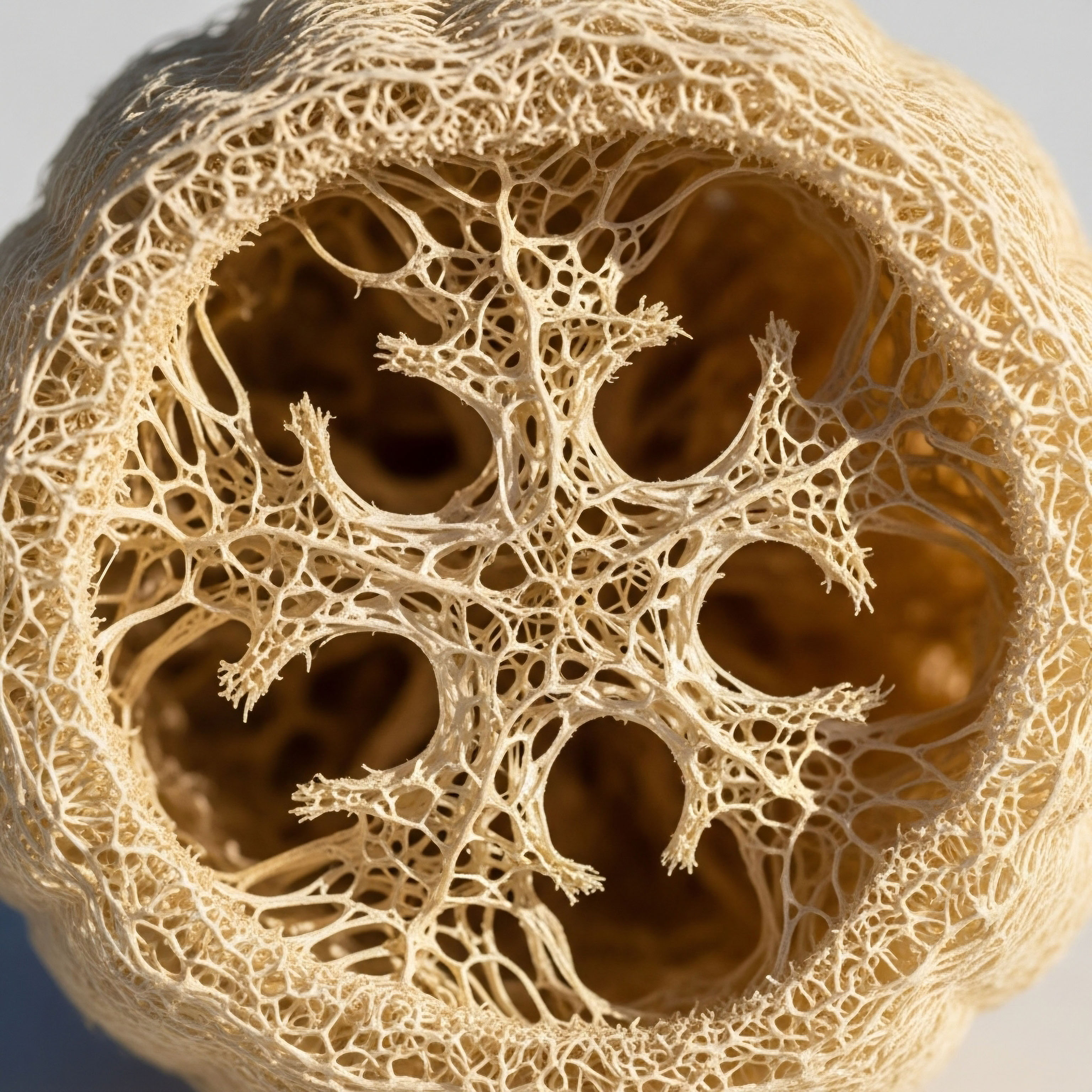

Fundamentals
You feel it before you can name it. A subtle shift in energy, a change in the way your body responds to exertion, or a new difficulty in maintaining focus. These experiences are common threads in the personal health narratives of many adults.
Often, these feelings are the first signal that your internal biological systems are undergoing a transformation. When you begin to connect these subjective feelings to measurable markers like blood pressure, you start a critical journey of self-knowledge. Understanding how a foundational hormone like testosterone influences a vital sign such as blood pressure is a powerful first step in reclaiming control over your well-being.
Your body operates as a finely tuned network of communication. Hormones are the messengers in this network, carrying instructions from one part of the body to another to maintain a state of equilibrium known as homeostasis. Testosterone is one of the most significant of these messengers, particularly in men, but also with a vital role in women.
Its responsibilities extend far beyond sexual characteristics; it is a key regulator of muscle mass, bone density, mood, and metabolic function. Blood pressure, in turn, is the physical measurement of the force exerted by circulating blood upon the walls of your blood vessels.
This pressure is essential for life, as it drives the flow of oxygen and nutrients to every cell in your body. The regulation of this pressure is a complex, moment-to-moment process managed by your nervous system, kidneys, and, crucially, your endocrine system.

The Hormonal Influence on Vascular Tone
The connection between testosterone and blood pressure begins at the level of your blood vessels. These vessels are not rigid pipes; they are dynamic tubes lined with a delicate layer of cells called the endothelium. This layer is a critical control center for vascular health.
The endothelium produces molecules that instruct the smooth muscle in the vessel walls to either relax, widening the vessel and lowering pressure (vasodilation), or contract, narrowing the vessel and increasing pressure (vasoconstriction). One of the most important of these signaling molecules is nitric oxide (NO), a potent vasodilator.
Testosterone appears to have a complex relationship with this system. Some evidence suggests that healthy, physiological levels of testosterone support endothelial function and the production of nitric oxide, which helps maintain vascular flexibility and healthy blood pressure. When testosterone levels fall below an optimal range, as seen in conditions like hypogonadism, this supportive mechanism can be compromised.
This may contribute to endothelial dysfunction, a state where the blood vessels become less responsive and tend toward constriction, potentially leading to higher blood pressure over time.
The intricate relationship between testosterone and blood pressure is rooted in the hormone’s influence on the cells lining the blood vessels.

Systemic Effects and Metabolic Health
The influence of testosterone on blood pressure is not confined to the blood vessels alone. It is deeply intertwined with overall metabolic health, which is a major determinant of cardiovascular risk. Low testosterone levels are frequently associated with an increase in visceral fat (the fat surrounding your internal organs), insulin resistance, and inflammation. Each of these factors independently places stress on the cardiovascular system and can contribute to the development of hypertension.
For instance, visceral fat is metabolically active tissue that releases inflammatory signals and other substances that can disrupt normal blood pressure regulation. Insulin resistance, a condition where your body’s cells do not respond effectively to the hormone insulin, often leads to higher levels of both glucose and insulin in the bloodstream.
These elevated levels can damage the endothelium and activate parts of the nervous system that increase blood pressure. Therefore, by supporting lean muscle mass and healthy insulin sensitivity, optimal testosterone levels contribute indirectly, yet powerfully, to cardiovascular stability. Understanding this connection moves the conversation from a simple one-to-one relationship to a more holistic, systems-based view of your health.


Intermediate
To appreciate the sophisticated interplay between testosterone and blood pressure, we must examine the specific biological machinery that governs cardiovascular homeostasis. The body employs several overlapping systems to manage vascular pressure, and testosterone modulates key components of these systems. Its effects are mediated through direct actions on vascular cells and indirect influences on systemic regulatory pathways. The clinical implications of this relationship become particularly relevant when considering hormonal optimization protocols for individuals with diagnosed testosterone deficiency.

The Renin-Angiotensin-Aldosterone System
The Renin-Angiotensin-Aldosterone System (RAAS) is a primary hormonal cascade responsible for regulating blood pressure and fluid balance. Think of it as the body’s long-term pressure management system. When the kidneys sense a drop in blood pressure, they release an enzyme called renin.
Renin initiates a chain reaction that culminates in the production of a powerful vasoconstrictor called Angiotensin II. Angiotensin II narrows blood vessels throughout the body and also stimulates the release of aldosterone, a hormone that causes the kidneys to retain sodium and water, further increasing blood volume and pressure.
Androgens, including testosterone, appear to upregulate several components of this system. Research indicates that testosterone can increase the production of angiotensinogen (the precursor to all angiotensin peptides) in the liver and may increase the activity of Angiotensin-Converting Enzyme (ACE), the enzyme that generates Angiotensin II.
By amplifying the activity of the RAAS, testosterone can create a physiological environment that favors higher blood pressure. This is one of the core mechanisms through which hormonal status directly impacts the body’s primary pressure-control system. In a state of testosterone deficiency, the dynamics of this system can change, while supraphysiological levels (levels above the normal range) may over-stimulate it.

How Does Testosterone Directly Affect Blood Vessels?
Testosterone’s actions on blood vessels occur through two distinct types of pathways ∞ genomic and non-genomic. Understanding both is essential to grasp its dual role as both a potential vasodilator and a long-term contributor to vasoconstriction.
- Genomic Pathways ∞ These are the classical actions of a steroid hormone. Testosterone enters a cell, binds to an androgen receptor (AR), and the complex travels to the cell’s nucleus. There, it interacts with DNA to alter the expression of specific genes. Over hours or days, this can change the cell’s structure and function. For example, genomic actions of testosterone can, over time, upregulate the production of pro-constrictive factors like thromboxane A2 and endothelin-1, contributing to a state of increased vascular tone.
- Non-Genomic Pathways ∞ These actions are much more rapid, occurring in seconds to minutes. They do not involve changes in gene expression. Instead, testosterone interacts with receptors on the cell membrane, triggering immediate signaling cascades inside the cell. Some of these non-genomic effects are vasodilatory. For instance, acute administration of testosterone has been shown to cause relaxation of vascular smooth muscle, possibly by modulating ion channels that control muscle contraction.
This duality explains some of the conflicting observations in research. A single, acute dose of testosterone might temporarily lower blood pressure, while long-term exposure to certain levels, particularly when imbalanced with other hormones, may contribute to a sustained increase in blood pressure through genomic remodeling and RAAS activation.
Testosterone’s influence on blood pressure is a complex balance between its rapid, relaxing effects on blood vessels and its slower, gene-regulating actions that can increase vascular constriction over time.

Clinical Context of Testosterone Replacement Therapy
For an individual with clinically diagnosed hypogonadism, characterized by low testosterone levels and associated symptoms, Testosterone Replacement Therapy (TRT) is a standard intervention. A common protocol involves weekly intramuscular injections of Testosterone Cypionate. The goal of such a protocol is to restore testosterone levels to a healthy, physiological range, thereby alleviating symptoms and improving metabolic parameters. However, the impact on blood pressure must be carefully monitored.
One of the known side effects of TRT is an increase in hematocrit, which is the proportion of your blood volume occupied by red blood cells. Testosterone stimulates the production of red blood cells in the bone marrow.
An elevated hematocrit makes the blood more viscous, or thicker, which can require the heart to pump harder to circulate it, leading to an increase in blood pressure. This is a primary reason why regular blood work is a non-negotiable component of any responsible hormonal optimization protocol.
Another critical factor is the conversion of testosterone to estrogen via the aromatase enzyme. Estrogen has its own set of effects on the cardiovascular system, some of which are protective. In men on TRT, managing this conversion is key.
If estrogen levels become too high, it can lead to side effects, including water retention, which also increases blood volume and pressure. To manage this, a medication like Anastrozole, an aromatase inhibitor, is often included in the protocol to control the rate of estrogen conversion. The careful balancing of testosterone, estrogen, and hematocrit is central to achieving the benefits of TRT while mitigating cardiovascular risks.
| Parameter | Mechanism of Action | Clinical Management Strategy |
|---|---|---|
| Hematocrit | Testosterone stimulates red blood cell production (erythropoiesis), increasing blood viscosity. | Regular blood testing; dose adjustment; therapeutic phlebotomy (blood donation) if levels become too high. |
| Estradiol (E2) | Testosterone converts to estradiol via the aromatase enzyme; high levels can cause sodium and water retention. | Monitoring estradiol levels; use of an aromatase inhibitor like Anastrozole to control conversion. |
| Blood Pressure | The net effect of changes in hematocrit, fluid balance, RAAS activity, and direct vascular effects. | Regular monitoring at home and in-clinic; lifestyle modifications; potential adjustment of TRT protocol or addition of antihypertensive medication. |


Academic
A sophisticated analysis of testosterone’s role in blood pressure regulation requires moving beyond systemic overviews to the molecular level. The interaction between androgens and the vascular endothelium is a focal point of modern research, revealing a highly complex relationship governed by receptor signaling, enzymatic pathways, and the generation of reactive oxygen species.
Specifically, the balance between nitric oxide bioavailability and oxidative stress within the endothelial microenvironment appears to be a critical determinant of testosterone’s ultimate effect on vascular tone and pathophysiology.

Endothelial Nitric Oxide Synthase Regulation
The health of the endothelium is predicated on its ability to produce nitric oxide (NO), a gaseous signaling molecule synthesized by the enzyme endothelial nitric oxide synthase (eNOS). NO diffuses to adjacent vascular smooth muscle cells, activating a pathway that leads to relaxation and vasodilation. Testosterone’s influence on this process is multifaceted and appears to be concentration-dependent.
Physiological concentrations of testosterone have been shown in some studies to support eNOS activity. This may occur through non-genomic mechanisms, such as the rapid activation of intracellular signaling cascades (e.g. the PI3K/Akt pathway) that phosphorylate and activate the eNOS enzyme.
This provides a biochemical basis for the observation that men with hypogonadism often exhibit impaired endothelial-dependent vasodilation, a condition that can be improved with carefully managed TRT. This restorative effect is fundamental to the therapeutic rationale for normalizing testosterone in deficient men.
Conversely, both profound deficiency and supraphysiological levels of testosterone can be detrimental. In states of deficiency, the supportive signaling for eNOS activation is lost. At excessively high concentrations, as might be seen with androgen abuse, testosterone can paradoxically promote an environment of oxidative stress.
This occurs when the production of reactive oxygen species (ROS), such as the superoxide anion, overwhelms the cell’s antioxidant defenses. Superoxide rapidly reacts with nitric oxide to form peroxynitrite, a highly damaging molecule. This reaction not only consumes and inactivates NO, reducing its bioavailability, but peroxynitrite itself can “uncouple” the eNOS enzyme, causing it to produce more superoxide instead of NO. This creates a vicious cycle of endothelial dysfunction, inflammation, and a pro-hypertensive state.

What Is the Role of Asymmetric Dimethylarginine?
Another layer of regulation involves an endogenous molecule called asymmetric dimethylarginine (ADMA). ADMA is a competitive inhibitor of eNOS. By binding to the enzyme, it blocks the synthesis of nitric oxide. Levels of ADMA are regulated by another enzyme, dimethylarginine dimethylaminohydrolase (DDAH), which degrades ADMA. Some evidence suggests that testosterone may influence this axis.
In states of testosterone deficiency, DDAH activity may be reduced, leading to an accumulation of ADMA. This increase in the endogenous eNOS inhibitor provides another powerful mechanism through which low testosterone can directly contribute to endothelial dysfunction and impaired vasodilation, independent of other metabolic factors.
The ultimate impact of testosterone on blood vessels hinges on a delicate molecular balance between the production of vasodilating nitric oxide and the generation of damaging oxidative stress.

The Sympathetic Nervous System and Central Regulation
The autonomic nervous system, particularly the sympathetic nervous system (SNS), provides rapid, beat-to-beat control of blood pressure. The SNS acts via the release of catecholamines like norepinephrine, which bind to adrenergic receptors on blood vessels and the heart, causing vasoconstriction and an increased heart rate. There is substantial evidence that androgens modulate SNS activity.
Animal studies have demonstrated that testosterone can increase the synthesis of norepinephrine in sympathetic neurons and may enhance the sensitivity of vascular receptors to its effects. Furthermore, research points to a role for testosterone in the development and function of brain regions that are critical for central blood pressure control, such as the rostral ventrolateral medulla.
Androgen receptors are expressed in these key cardiovascular control centers, suggesting a direct central nervous system mechanism for testosterone’s influence on sympathetic outflow. An overactive SNS is a hallmark of many forms of hypertension, and androgen-mediated potentiation of this system represents a significant pro-hypertensive mechanism.
| Molecular Target | Effect of Physiological Testosterone | Effect of Deficient or Supraphysiological Testosterone |
|---|---|---|
| eNOS Activity | Supports NO production via non-genomic activation of signaling pathways (e.g. PI3K/Akt). | Deficiency leads to reduced NO production. Supraphysiological levels can promote oxidative stress, leading to eNOS uncoupling. |
| ADMA/DDAH Axis | May support DDAH activity, leading to lower levels of the eNOS inhibitor ADMA. | Deficiency may decrease DDAH activity, causing ADMA to accumulate and inhibit NO synthesis. |
| Reactive Oxygen Species (ROS) | Maintains a healthy balance between ROS production and antioxidant defenses. | Supraphysiological levels can increase ROS production from sources like NADPH oxidase, leading to oxidative stress. |
| Sympathetic Nervous System | Maintains normal sympathetic tone and central regulation. | May increase norepinephrine synthesis and sensitivity, leading to heightened sympathetic outflow and vasoconstriction. |

Are There Sex-Specific Differences in Blood Pressure Regulation?
The well-documented differences in blood pressure and cardiovascular disease risk between men and premenopausal women underscore the profound influence of sex hormones. While men have higher androgen levels, premenopausal women have higher estrogen levels. Estrogen generally opposes the pro-hypertensive actions of the RAAS.
It tends to decrease ACE activity and AT1 receptor density while promoting vasodilatory pathways. After menopause, as estrogen levels decline, this protective effect diminishes, and the incidence of hypertension in women rises to match that of men. This natural biological model provides compelling evidence for the powerful role hormones play in setting the long-term trajectory of cardiovascular health.
The higher baseline activity of pro-hypertensive systems like the RAAS and SNS in men, partly driven by testosterone, is a key factor in their higher lifetime risk of hypertension.

References
- Reckelhoff, Jane F. “Gender and the renin-angiotensin-aldosterone system.” Fundamental & Clinical Pharmacology, vol. 24, no. 6, 2010, pp. 687-98.
- Chignalia, Andrea Z. et al. “Testosterone and Secondary Hypertension ∞ New Pieces to the Puzzle.” Hypertension, vol. 61, no. 1, 2013, pp. e1-e2.
- Traish, Abdulmaged M. “Testosterone and the Heart.” Uro, vol. 1, no. 1, 2021, pp. 26-42.
- Hotta, Y. et al. “Testosterone Deficiency and Endothelial Dysfunction ∞ Nitric Oxide, Asymmetric Dimethylarginine, and Endothelial Progenitor Cells.” Sexual Medicine Reviews, vol. 7, no. 4, 2019, pp. 661-668.
- Vigen, R. et al. “Association of testosterone therapy with mortality, myocardial infarction, and stroke in men with low testosterone levels.” JAMA, vol. 310, no. 17, 2013, pp. 1829-36.
- Jones, T. Hugh. “The effect of testosterone on cardiovascular disease and cardiovascular risk factors in men ∞ a review of clinical and preclinical data.” Asian Journal of Andrology, vol. 20, no. 2, 2018, pp. 115-121.
- Spitzer, M. et al. “The effect of testosterone on the renin-angiotensin system in men.” The Journal of Clinical Endocrinology & Metabolism, vol. 98, no. 4, 2013, pp. 1614-22.
- Budoff, M. J. et al. “Testosterone Treatment and Coronary Artery Plaque Volume in Older Men with Low Testosterone.” JAMA, vol. 317, no. 7, 2017, pp. 708-716.
- Cleveland Clinic. “Hormones ∞ What They Are, Function & Types.” Cleveland Clinic, 2022.
- Reckelhoff, J. F. and Y. Yanes. “Testosterone and blood pressure regulation.” Current Opinion in Nephrology and Hypertension, vol. 17, no. 2, 2008, pp. 138-43.

Reflection

Charting Your Own Biological Course
The information presented here offers a map of the complex biological territory where your hormonal health and cardiovascular function meet. This map details the intricate pathways, the cellular dialogues, and the systemic pressures that define your internal environment. Its purpose is to transform abstract symptoms into understandable processes, providing a framework for your personal health story.
The knowledge that your feelings of vitality are connected to the function of your endothelial cells, or that your metabolic health directly informs your blood pressure, is empowering.
This understanding is the starting point. Your unique physiology, genetics, and life experiences create a reality that no chart can fully capture. The next step in this journey involves looking inward, armed with this new perspective. How do these systems feel in your own body?
Where do you see reflections of this science in your own energy, resilience, and well-being? This process of introspection, combined with objective data from clinical assessments, allows you to move from a general understanding to a personalized strategy. Your path to sustained vitality is one that you navigate, guided by knowledge and in partnership with clinical expertise. The potential for proactive, informed stewardship of your own health is immense.



